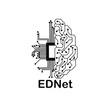ednet_cms 1.0.0  ednet_cms: ^1.0.0 copied to clipboard
ednet_cms: ^1.0.0 copied to clipboard
Semantic CMS tools
EDNet CMS #
Your Content Management Superpower for Flutter
Hey Flutter devs! 👋 Ready to supercharge your content management game? EDNet CMS is here to make your life easier when building complex, content-rich Flutter apps.
What's EDNet CMS? #
EDNet CMS is your secret weapon for creating multiplatform, web-integrated, business-rich MVPs. It's not just a library; it's a whole new way of thinking about content management in Flutter, complete with a powerful interpreter app called EDNet One.
Why EDNet CMS? #
Ever felt like content management in your apps is a bit... messy? Us too. That's why we created EDNet CMS. Here's what makes it special:
-
Content is King (and Queen): We recognize that content is everywhere, often recursive, and self-defined. Sounds complex? That's because it is! But don't worry, we've got you covered.
-
User-Centric Approach: We model content primarily based on how users interact with it in different contexts. It's all about that user experience!
-
Abstraction Level: Expert: We elevate the abstraction level above the current web landscape, making it easier to map content across different user contexts.
Our Secret Sauce #
We've baked in some seriously cool principles:
- Human Biology: We consider how humans physically interact with content.
- Human Psychology: We design with the human mind in focus, making UIs that just make sense.
- Digital Realism: We account for the limitations of digital products in our design process.
The EDNet CMS Method #
We're all about opinionated abstractions:
- Custom Language: We speak your domain's language.
- Event Storming: Capture your system's dynamics visually.
- Domain-Driven Design: Your code structure mirrors your business logic.
- Code Generation: Less boilerplate, more productivity.
Getting Started #
-
Add
ednet_coreandednet_cmsto yourpubspec.yaml:dependencies: ednet_core: latest ednet_cms: latest dev_dependencies: build_runner: latest -
Model your domain: Create
.ednet.yamlfiles inlib/requirements/for each of your bounded contexts.Example:
# lib/requirements/household/finance/finance.ednet.yaml domain: Household model: Finances concepts: - name: Income attributes: - name: amount type: number - name: source type: string - name: Expense - name: Budget - name: Transaction -
Start the build_runner in watch mode:
dart run build_runner watch --delete-conflicting-outputs -
Generated OneApplication is entry point into your domain models.
-
Use EDNet One to visualize and interact with your domain model:
flutter run
EDNet One: Your Domain Model Navigator #
EDNet One is a multiplatform Flutter application that brings your EDNet.dev domain models to life:
- Master-Detail UX Pattern: Drill down from domains to models to entities seamlessly.
- Interactive Graph View: Visualize entity relationships across domains.
- Multiplatform Support: Run on Android, iOS, Web, and Desktop.
- Theme Support: Switch between light and dark themes.
🚀 Features #
- In-Vivo Domain Model Editing: Modify your domain model directly within the app.
- DBpedia and SPARQL Integration: Enrich your data with vast knowledge graphs.
- Generative AI: Get AI-assisted suggestions for model and UI improvements.
- API Integration: Connect with calendar, email, project management, and more.
📝 Usage #
-
Clone the repository:
git clone https://github.com/ednet-dev/cms.git -
Navigate to the EDNet One directory:
cd cms/apps/one -
Install dependencies:
flutter pub get -
Refer to Getting Started
-
Run the application:
flutter run
Join the EDNet.dev Community #
We're not just building a library; we're cultivating a community of Flutter developers who believe in building scalable, maintainable apps. Join us on GitHub to contribute, report issues, or just say hi!
📄 License #
Individual packages and applications within this repository have their own licenses, - see the LICENSE file for details.
📧 Contact #
For more information, please contact our dev team.

Explore • Interact • Integrate
